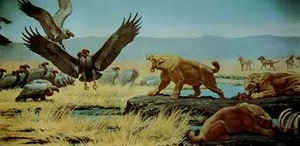Nevada State Fossil
Ichthyosaur

(genus Shonisaurus)
Adopted in 1977.
Nevada designated Ichthyosaur (genus Shonisaurus) as the official state fossil in 1977.
Berlin-Ichthyosaur State Park is a state park of Nevada, United States, preserving several undisturbed ichthyosaur fossils of the species Shonisaurus popularis, as well as the early-20th-century ghost town of Berlin.
Nevada State Fossil: Ichthyosaur

Ichthyosaurs swam through prehistoric seas for more than 150 million years, almost as long as their dinosaur cousins ruled the land. While some of the creatures retained the lizard like proportions of their ancestors, others were as sleek as porpoises and probably had a lifestyle similar to that of those modern mammals. Analyses of ichthyosaur fossils are shedding new light not only on their body structure, but also on what they ate and how they may have homed in on their prey. Fossils still being teased from the rock strongly hint that the largest predator ever on our planet may well have been an ocean-dwelling ichthyosaur.
The Ichthyosaurus shonisaurus popularis was the name given to a species discovered in Nevada in 1928. (Although reports state the discovery was in 1928, the expedition to the Humboldt region is referred to as: The Saurian Expedition of 1905). Some 37 of these reptiles became stranded in mud flats from a receding equatorial sea which once covered the state. The longest specimen found at this site, located at an elevation of 7,000 feet in the Shoshone Mountain Range near the town of Berlin in northwestern Nye County, Nevada, was 55 feet long and represented the only complete fossilized skeleton of the species ever found in the United States.

At the turn of the century, the Berlin mine and mill processed silver and gold ore from nearby Union Canyon. When miners discovered ichthyosaur
fossils in Union Canyon, they used them as decorations in their fireplace hearths. The large disc-shaped vertebrae were used as dinner plates.
Paleontologists later studied the site more closely and discovered the remains that had died about 225 million years ago, during the Triassic Period.
Ichthyosaurs were stream-lined marine reptiles that ranged in size from 7-30 feet long (4.5-9 m). They had sharp teeth in long jaws, and big eyes. They had four crescent-shaped fins, a stabilizing dorsal fin, and a fish-like tail with two lobes. They breathed air with lungs through nostrils which were close to the eyes near the top of the snout. They gave birth to live young; fossils have been found with baby Ichthyosaurs in the abdomen.
A reinterpretation of the Upper Triassic ichthyosaur Shonisaurus
McGowan, C Motani, R, Journal of Vertebrate Paleontology, 1999, 19(1): 42
Shonisaurus, from the Upper Triassic (Carnian) of Nevada, is represented by some 40 individuals. However, many comprise only a few elements, and not
one of the skeletons is complete. Furthermore, preservation is often poor, so information is limited. Reaching lengths of up to 15 m, possibly slightly
more, Shonisaurus was about the size of a Gray Whale. The only other ichthyosaur of comparable size was a little known and unnamed ichthyosaur from
the English Lower Jurassic, which may have reached 15 m (McGowan, 1996). Shonisaurus was long-bodied, with about 60 presacral vertebrae. Some of the
centra, at about the level of the 97th vertebra, are wedge-shaped, indicating a tailbend. However, their cambers are small, and their combined angle
of deflection is only about 5 degrees, which hardly constitutes a tailbend. The paired fins were long and slender, with no more than three major digits
in each, possibly only two. Contrary to previous descriptions, the emarginations on the free margins of many of the fin elements were probably preaxial
rather than postaxial, as in all other ichthyosaurs. The coracoid does not have a hooked process distally, and is therefore much like that of Shastasaurus.
The teeth are set in individual sockets, as previously described. Three species have been described, but S. popularis is here considered the
only valid species.
Nevada Law
The law designating the Ichthyosaur as the official Nevada state fossil is found in the Nevada Revised Statutes, Title 19, Chapter 235, Section 235.080.
TITLE 19 - MISCELLANEOUS MATTERS RELATED TO GOVERNMENT AND PUBLIC AFFAIRS.
CHAPTER 235. STATE EMBLEMS; GIFTS AND ENDOWMENTS, MISCELLANEOUS SYMBOLS.
SECTION 235.080.
235.080 State fossil. The prehistoric marine reptile known as the Ichthyosaur (genus Shonisaurus), now extinct, is hereby designated
as the official state fossil of the State of Nevada.
(Added to NRS by 1977, 272; A 1989, 1038)
Taxonomic Hierarchy: Ichthyosaur
Kingdom: Animalia - animals
Phylum: Chordata - chordates
Subphylum: Vertebrata - vertebrates
Class: Reptilia - reptiles
Order: Ichthyosauria or Ichthyopterygia
Family: Muscicapidae - old world flycatchers
Genus: Shonisaurus
Species: *

Some states that lack a "state fossil" have nevertheless singled out a fossil for formal designation such as a state dinosaur, rock, gem or stone.







